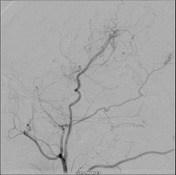Moyamoya
Diagnosis certain
Updates to Case Attributes
Body
was changed:
Moyamoya is characterized by stenosis of intracranial arteries, usually involving the ICA, ACA, and MCA (Gross et al., Hemorrhagic and Ischemic Stroke). The disease typically plesents with prominent lenticulostriate and thalamic perforating arteries, which contribute to the "puff of smoke" appearance (Gross et al.). The incidence of moyamoya is higher in Asian-American populations (Gross et al.), and the patient presented in this case was a female of Korean descent.
Procedure performed and dictated by Rakesh Shah, M.D. Case courtesy of Rakesh Shah, M.D.
-<p>Moyamoya is characterized by stenosis of intracranial arteries, usually involving the ICA, ACA, and MCA (Gross et al., Hemorrhagic and Ischemic Stroke). The disease typically plesents with prominent lenticulostriate and thalamic perforating arteries, which contribute to the "<a title="Puff of smoke appearance" href="/articles/puff-of-smoke-sign">puff of smoke</a>" appearance (Gross et al.). The incidence of moyamoya is higher in Asian-American populations (Gross et al.), and the patient presented in this case was a female of Korean descent. </p>- +<p>Moyamoya is characterized by stenosis of intracranial arteries, usually involving the ICA, ACA, and MCA (Gross et al., Hemorrhagic and Ischemic Stroke). The disease typically plesents with prominent lenticulostriate and thalamic perforating arteries, which contribute to the "<a href="/articles/puff-of-smoke-sign">puff of smoke</a>" appearance (Gross et al.). The incidence of moyamoya is higher in Asian-American populations (Gross et al.), and the patient presented in this case was a female of Korean descent. </p><p>Procedure performed and dictated by Rakesh Shah, M.D. Case courtesy of Rakesh Shah, M.D.</p>
References changed:
- Oshima H, Katayama Y. Discovery of cerebrovascular moyamoya disease: research during the late 1950s and early 1960s. (2012) Child's nervous system : ChNS : official journal of the International Society for Pediatric Neurosurgery. 28 (4): 497-500. <a href="https://doi.org/10.1007/s00381-012-1708-x">doi:10.1007/s00381-012-1708-x</a> - <a href="https://www.ncbi.nlm.nih.gov/pubmed/22327249">Pubmed</a> <span class="ref_v4"></span>
- Ross IB, Shevell MI, Montes JL, Rosenblatt B, Watters GV, Farmer JP, O'Gorman AM. Encephaloduroarteriosynangiosis (EDAS) for the treatment of childhood moyamoya disease. (1994) Pediatric neurology. 10 (3): 199-204. <a href="https://www.ncbi.nlm.nih.gov/pubmed/8060421">Pubmed</a> <span class="ref_v4"></span>
- Oshima and Katayama. "Discovery of cerebrovascular moyamoya disease: research during the late 1950s and early 1960s." Child's Nervous System, Vol. 28, Issue 4. April 2012. pp. 497-500.
- Ross et al. "Encephaloduroarteriosynangiosis (EDAS) for the treatment of childhood moyamoya disease." Pediatric Neurology, Volume 10, Issue 3. May 1994. pp. 199-204. http://www.sciencedirect.com/science/article/pii/088789949490023X
Updates to Study Attributes
Images Changes:
Image DSA (angiography) (Internal carotid artery) ( update )

Description
was removed: